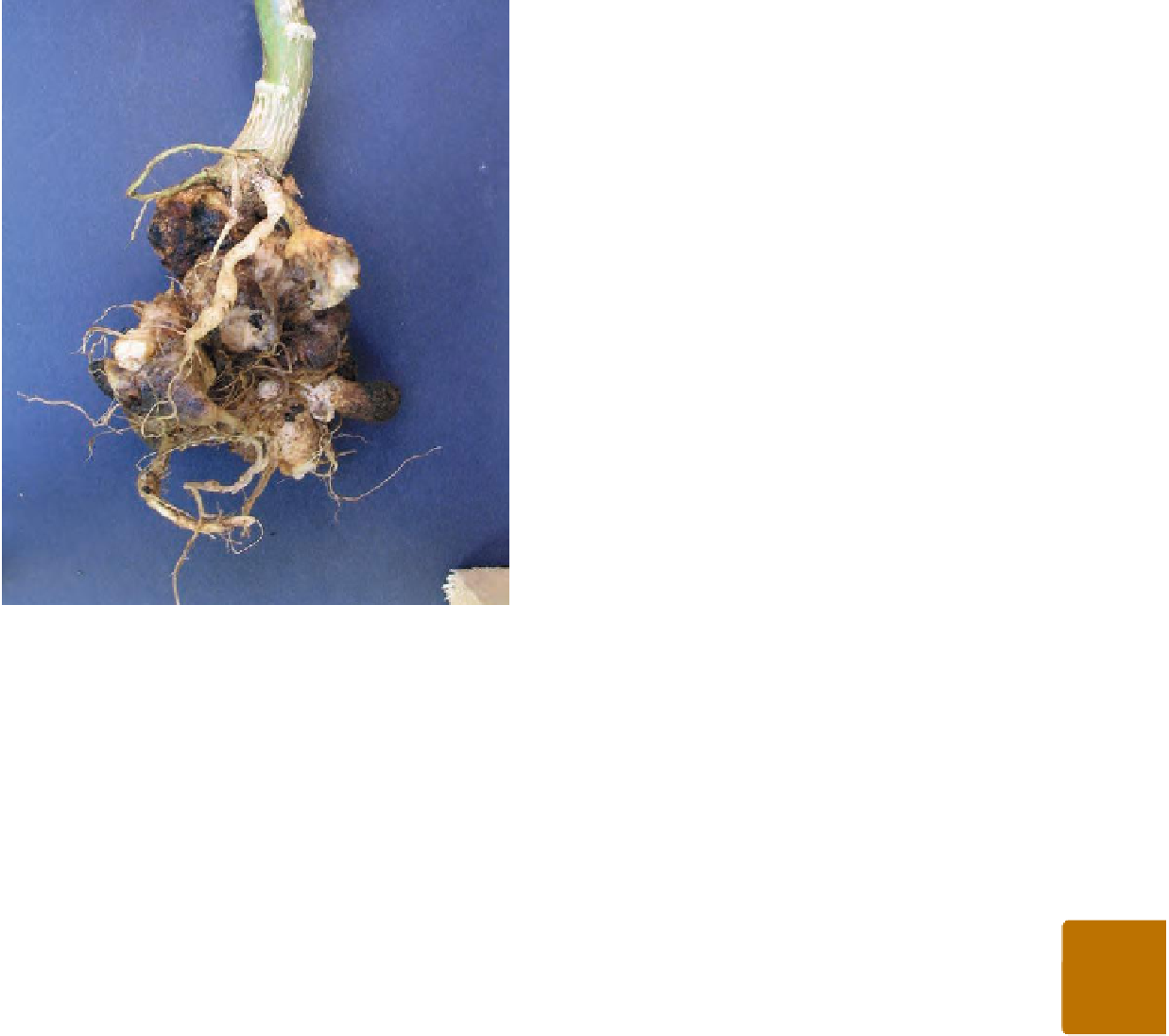Agriculture Reference
In-Depth Information
Life cycle and spread
. The club root organism survives
in the soil for more than five years as minute spores
which germinate to infect the root hairs of susceptible
plants. The fungus is unusual in forming a jelly-like
mass (plasmodium), not hyphae, within the plant's
root tissues. The plasmodium stimulates root cell
division and causes cell enlargement, which produces
swollen roots. The flow of food and nutrients in
phloem and xylem is disturbed, with consequent poor
growth of the plant. With plant maturity, the spores
produced by the plasmodium within the root are
released as the root rots. The disease is favoured by
high soil moisture, high soil temperatures and acid
soils.
Although this fungus does not spread much in
undisturbed soils, it can easily be carried on infected
plants, or on tools and wheels of garden machinery
such as rotavators. In peat soil-growing areas, high
winds may carry the disease a considerable distance.
Control
. Several physical and cultural control measures
may be used by the gardener. Rotation greatly helps
by keeping cruciferous crops away from high spore
concentrations in the soil. Liming of soil inhibits spore
activity (see p. 176). Recently released cultivars of
summer cabbage (such as 'Kilaxy'), cauliflowers
(such as 'Clapton'), swedes (such as 'Invitation') and
Brussels sprouts (such as 'Crispus F1') are claimed
to have strong resistance to club root. Autumn-sown
plants establish in soil temperatures less favourable
to the disease and are normally less infected.
Composting infected brassica plants should be
avoided. Transplants grown in a club root-free bed are
more able to establish when planted into vegetable
plots. No chemical controls against this disease are at
present available to gardeners.
Figure 19.8
Club root symptoms on roots of cabbage
Control
. It is not advisable to grow brassicas year after
year in the same field, and particularly not to sow in
spring next to overwintered crops.
The gardener can use a product containing the
protectant fungicide copper oxychloride. As complete
a cover of the spray as possible ensures that the
'fungus' is prevented from establishing itself.
Other crops such as lettuce and onions are attacked
by equally important, but different species of downy
mildews (
Bremia lactucae
and
Perenospora destructor
,
respectively). No cross-infection is seen between
crops such as cabbage, lettuce and onions, which
belong to different plant families.
Powdery mildew on strawberry
(
Podosphaera aphanis
)
19
This belongs to the Ascomycota group of fungi.
Powdery mildews should not be confused with downy
mildews (see p. 255) that are an unrelated group of
fungus-like organisms. Powdery mildews prefer hot
dry conditions whilst downy mildews occur most
commonly in cool damp conditions.
Damage
. The first symptoms on strawberry are
often purple spots seen on the upper leaf surface,
and sometimes on the lower leaf surface. A slightly
fluffy dry white infection (see Figure 19.9) is then
seen gradually covering areas of the upper leaf
surface. Darkened areas on the upper leaf may
indicate infection on the lower leaf surface. Leaves
eventually turn brown and leaf edges curl. The loss of
photosynthesis in the leaves leads to reduced plant
Club root (
Plasmodiophora brassicae
)
This fungus is classified into a quite separate group of
fungi, the Plasmodiophorales.
Damage
. It causes serious damage to most members
of the Brassicaceae (Cruciferae) family, which includes
edible crops such as cabbage, cauliflowers and
Brussels sprouts; and ornamentals such as wallflowers,
stocks and
Alyssum
. Infected plants show signs of
wilting and yellowing of older leaves, and often severe
stunting. On examination, the roots appear stubby and
swollen (Figure 19.8), and may show a wet rot.

